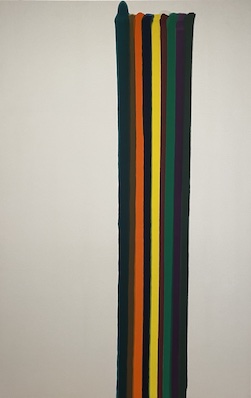Morris Louis facts for kids
Quick facts for kids
Morris Louis
|
|
|---|---|
| Born |
Morris Louis Bernstein
November 28, 1912 |
| Died | September 7, 1962 (aged 49) |
| Nationality | American |
| Education | Maryland Institute College of Art |
| Known for | Painting |
|
Notable work
|
Museum of Modern Art, Metropolitan Museum of Art, Hirshhorn Museum and Sculpture Garden |
| Movement | Color Field painting, Abstract Expressionism, Post-painterly abstraction, Washington Color School |
Morris Louis (born Morris Louis Bernstein on November 28, 1912 – died September 7, 1962) was an American painter. He became famous in the 1950s for a style called Color Field painting. While living in Washington, D.C., Morris Louis and other artists like Kenneth Noland started an art group. This group is now known as the Washington Color School.
Contents
Early Life and Art Training
Morris Louis was born in Baltimore, Maryland. From 1929 to 1933, he studied art at the Maryland Institute of Fine and Applied Arts. He received a scholarship to help pay for his studies. He left school just before finishing his program.
To support himself while painting, Louis took many different jobs. In 1935, he became the president of the Baltimore Artists' Association. From 1936 to 1940, he lived in New York City. There, he worked for a government art program called the Works Progress Administration Federal Art Project. During this time, he met other artists like Arshile Gorky. He also decided to drop his last name, Bernstein, and became known simply as Morris Louis.
His Unique Painting Style
What is Color Field Painting?
In 1940, Louis moved back to Baltimore and taught art privately. In 1948, he started using a new type of paint called Magna paint. This was a special oil-based acrylic paint made for him by his friends.
In 1952, Louis moved to Washington, D.C.. He worked mostly by himself, away from the busy New York art scene. In the 1950s, he and other artists like Kenneth Noland and Gene Davis helped create Color Field painting. This style focused on large areas of color.
Color Field painters wanted to make paintings simpler. They used big areas of thin, flowing paint on raw canvas. They often used bright, flat colors and repeated patterns. This was different from other art styles that used lots of brushstrokes or detailed drawings.
How He Stained the Canvas
In 1953, Louis and Noland visited artist Helen Frankenthaler's studio in New York. They were very impressed by her "stain paintings," especially one called Mountains and Sea (1952).
After their visit, Louis and Noland started trying new ways to apply paint. Louis would often use very thin, watery paint on canvas that wasn't prepared with a primer. He let the paint flow down the canvas, creating soft, see-through layers of color. This made the colors look like thin veils. Frankenthaler's work helped Louis develop this special technique.
Louis tried to remove any visible brushstrokes from his paintings. His thin paint would soak into the canvas, becoming part of the fabric itself. This made the painting look very flat.
One of his most famous series of paintings is called the Veil Paintings. These paintings have many layers of transparent color poured onto the canvas. The colors seem to blend and overlap, creating rich, deep shades. In another series, he used long, parallel stripes of pure color, like a rainbow. The painting Tet is a great example of his Veil Paintings.
Later Works

Morris Louis destroyed many of his paintings between 1955 and 1957. He started working on his Veils again in 1958–59. After that, he created other series like Florals and Columns (1960).
He also made the Unfurleds (1960–61). In these paintings, streams of bright, strong color flow from the sides of a large, empty white space in the middle of the canvas. Between 1960 and 1961, he made about 150 Unfurleds, many of them very large. His last works were the Stripe paintings (1961–62).
Exhibitions and Legacy
After Morris Louis passed away, many museums showed his artwork. A special exhibition was held at the Solomon R. Guggenheim Museum in 1963. Other major shows took place at the Museum of Fine Arts in Boston (1967) and the National Gallery of Art in Washington, D.C. (1976).
In 1986, the Museum of Modern Art (MoMA) in New York had a big show of his works. More recently, from 2007 to 2008, his art was shown in museums in San Diego, Atlanta, and Washington, DC.
Personal Life and Death
Morris Louis married Marcella Siegel in 1947. She supported his art career. After he died, she helped young artists each year through the Morris Louis Fellowship at George Washington University.
Morris Louis was diagnosed with lung cancer in 1962 and died soon after, on September 7, 1962, at his home in Washington, D.C. It is believed that his illness was caused by breathing in paint fumes for a long time.
See also
 In Spanish: Morris Louis para niños
In Spanish: Morris Louis para niños
- Color field painting
- Washington Color School
- Post-painterly abstraction
- Magna paint

